#jōmon period
Text

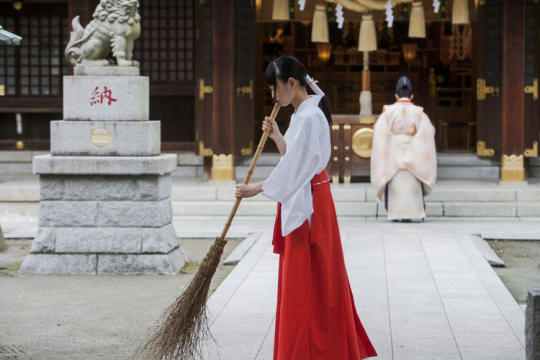


Sean bienvenidos mis queridos fanáticosarqueológicos a una nueva entrega de prehistoria Japónesa en esta ocasión nos trasladamos a la pregunta ¿Cuándo se originó el sintoísmo?.
-
Aunque parezca raro es una religión que se conformo durante el periódo Jōmon (17.500-300), para ser exactos a finales de dicho período y continua hasta nuestros días los dioses del sintoísmo, se les llama Kamis ( dios) ya que para los japoneses todo tenía un dios las montañas, ríos.
-
El sintoísmo tiene influencias chinas, coreanas de hay que tenga similitudes con el taoísmo, ¿Qué dos libros recogen la categoría de los Kamis? Son el Kojiki(713d.c) y el Nihonshoki(720d.c).
-
Espero que os guste y nos vemos en una próxima públicacion un cordial saludo.
🇯🇵
私の愛する考古学ファンを日本の先史時代の新作に歓迎します。今回は、神道がいつ始まったのかという質問に移ります。
-
奇妙に思えるかもしれませんが、縄文時代(17500-300)に形成された宗教であり、正確にはその時代の終わりに、今日まで神道の神であり、カミス(神)と呼ばれています。 日本人にとって、山や川にはすべて神がいました。
-
神道は中国、韓国の影響を受けており、道教との類似点があります。 カミスのカテゴリーに分類される2冊の本は何ですか? こうじき(713d.c)と日本書紀(720d.c)です。
-
よろしくお願いします。次の出版物で心からのご挨拶を申し上げます。
🇬🇧
Welcome my dear archaeological fans to a new installment of Japanese prehistory, this time we move to the question, when did Shintoism originate?
-
Although it may seem strange, it is a religion that was formed during the Jōmon period (17500-300), to be exact at the end of that period and continues to this day the gods of Shintoism, they are called Kamis (god) since for the Japanese everything the mountains and rivers had a god.
-
Shintoism has Chinese, Korean influences, and there are similarities with Taoism. What two books are classified under the category of the Kamis? They are the Kojiki (713d.c) and the Nihonshoki (720d.c).
-
I hope you like it and see you in a next publication a cordial greeting.
#kamis#kami#japanese gods#history#japan#jōmon#jōmon period#prehistory#japanese prehistory#taoism#china#korea#religious history#kojiki#Nihonshoki#カミス#カミ#日本の神々#歴史#日本#城門#ピリオドジョモン#先史時代#先史時代日本人#道教#中国#韓国#ヒストリアレリギオーザ#コジキ#日本書紀
88 notes
·
View notes
Text
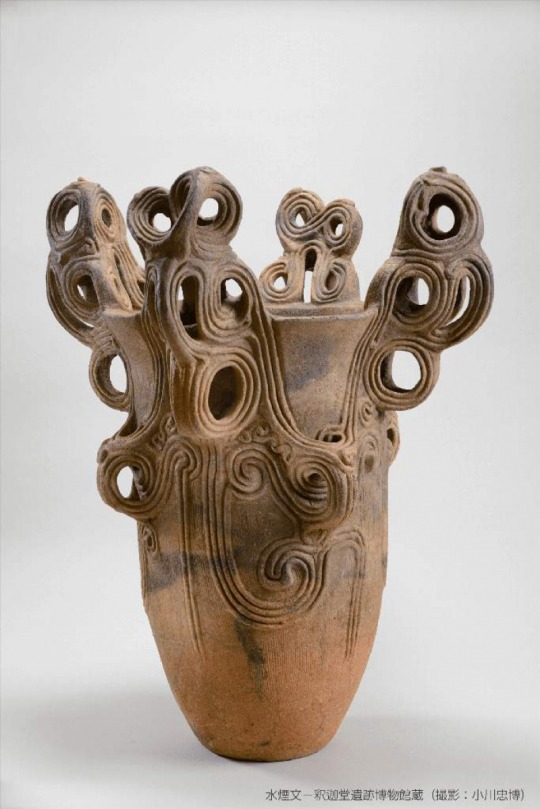
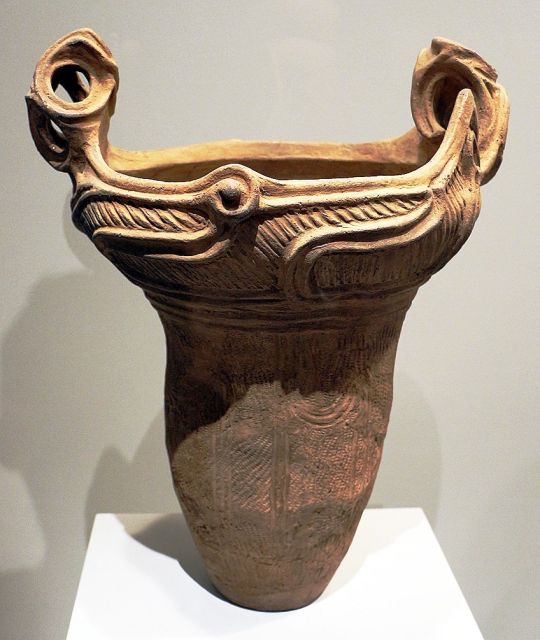
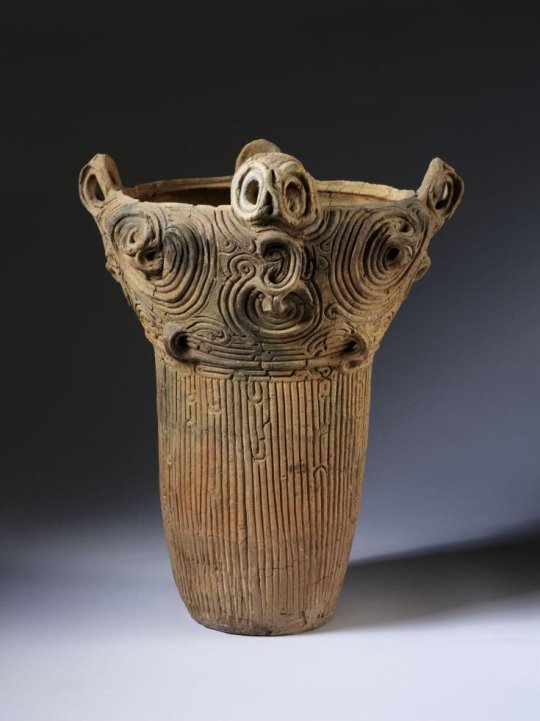

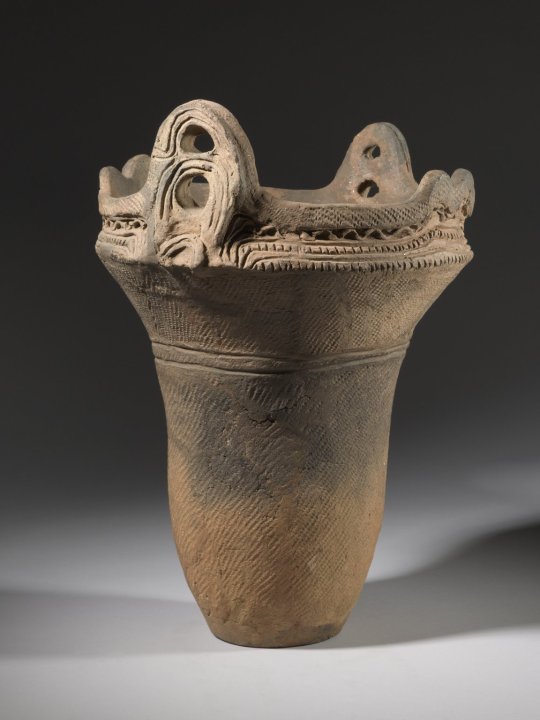
JŌMON POTTERY VESSELS ARE THE OLDEST IN THE WORLD..."
PIC INFO: Spotlight on a Neolithic Jomon vessel from Japan, c. Middle Jōmon Period (c. 3,500? - 2,500 BCE), designated National Important Cultural Properties in 1988.
MINI-OVERVIEW: "Jōmon pottery vessels are the oldest in the world. They are characterized by their decoration from impressions, which resemble rope. The word Jōmon means "cord markings" or "patterns."
Because the Jōmon period covered a great deal of time, the vessels themselves changed throughout the period.
THE ART OF EDUCATION (University)
Address: Fuefuki City Yamanashi
Category: Cultural Heritage/Japan Heritage
Source: https://jomon.co/en/point/detail/14, The Art of Education, Met Museum, Explore the Collections, Brooklyn Museum, various, etc...
#Japanese Pottery#Japanese#Pottery#Jakado Site#Japan#Ancient Japan#Ancient Japanese#Ancient Pottery#Ancient Cultures#Ancient Civilizations#Middle Jomon Period#Jōmon Culture#Middle Jōmon Period#Jōmon Vessel#Vessel#Jōmon Vessels#Jomon Pottery#Pottery Vessels#Jōmon Pottery#Jōmon#Jōmon Period#Vessels#Archeology#Japanese Neolithic Pottery#Jōmon Ware
9 notes
·
View notes
Text





PUTS THEM IN A SITUATION!!! Explanation for their pokemon under cut!
Bandit;
Arctovish: It’s a fossil pokemon! (You know since he’s an archaeologist) + it’s blue
Baltoy: It’s based on a 遮光器土偶 Shakōki-dogū—a "spaceman" clay figurine from the Jōmon period of Japanese history, so an ancient relic! + color scheme reasons
Psyduck: I felt it in my heart. Banditcore pokemon + color scheme reasons. He found it all on its own when he was 10 and since then it’s REFUSED to evolve.
Omanyte: It’s a fossil pokemon! + it’s blue
Chil;
Rapidash: A reference to her horse in dragon !!(˚ ˃̣̣̥⌓˂̣̣̥ ) I like to imagine her mum gifted it to her while it was still a ponyta!
Kangastan: She’s Australian. Also it has strong motherly urges to protect its children! I think she found it mourning its lost child and felt a sort of kinship (cough cough “the show”)
Combusken: this might be a stretch but she references being a mother hen in “sleepytime”. Also I felt it in my heart
I was initially going to add a Flareon or a Vulpix but got lazy whoops
#art#bluey#pokemon#pokemon art#bluey cartoon#bandit heeler#chili heeler#chilli heeler#bluey fanart#pokemon au#bluey au#Quotidianish
229 notes
·
View notes
Text
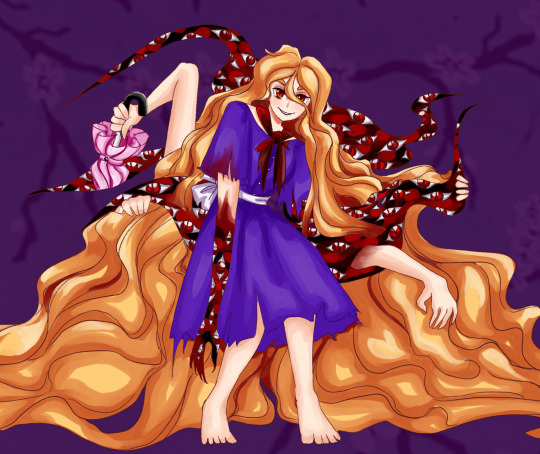
Come to the Jōmon period!
We have:
-Pottery
-Tree bark textiles
-Rice maybe
-This fucking thing?
#幻#touhou#yukari yakumo#maribel hearn#Technically speaking it's not either of them but bear with me.#yukari#maribel#yukaribel
397 notes
·
View notes
Text
Time Travel Question 16: Ancient History VII and Earlier
These Questions are the result of suggestions from the previous iteration.
This category may include suggestions made too late to fall into the correct grouping.
Please add new suggestions below if you have them for future consideration.
I am particularly in need of more specific non-European suggestions in particular, but all suggestions are welcome.
#Time Travel#Morocco#Phoenicia#The Mediterranean#The Xia Dynasty#Pompeii#Domestication#Agricultural Revolution#Finish history
317 notes
·
View notes
Text

Deep Pot
Japanese, c. 2000–1000 B.C.
Roughly two-thirds of this pot’s surface is covered by intersecting ribbons made up of incised lines and additional decoration created by impressing a cord into the clay. On the rim, the decoration continues on four spool-shaped protrusions. The tall, conical form is a rare shape in ceramics of the Jōmon period. Only one other pot of this exact shape is known (Tokyo National Museum); it was excavated at the Horinouchi site near Funabashi, Chiba (east of Tokyo), and it is likely that this jar was unearthed in the same region. Several jars were recovered from this location, making it one of the most prominent sites of early Japanese pottery.
132 notes
·
View notes
Text
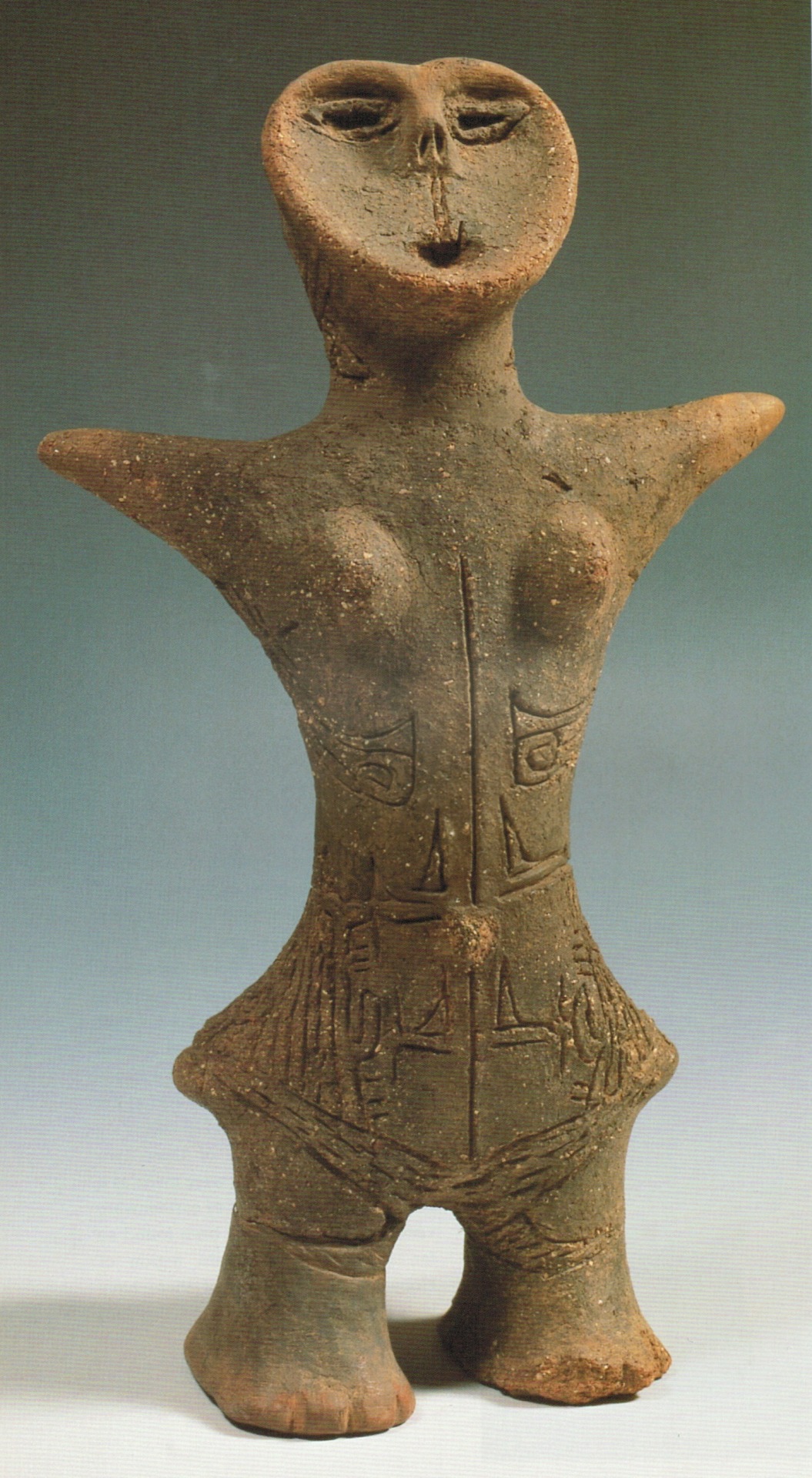
A clay figurine dating to the Middle Jōmon period (2500 BC to 1500 BC) excavated at the Sakaue Site in Nagano Prefecture and currently in the collection of the Idojiri Archaeological Museum (井戸尻考古館) in Fujimi, Nagano Prefecture
Image from "Shintō: The Sacred Art of Ancient Japan" edited by Victor Harris, published by the British Museum Press. 2001, page 80
#japanese art#prehistoric art#clay figurine#長野県#nagano prefecture#富士見町#fujimi#crazyfoxarchives#arte japonés#arte prehistórico
129 notes
·
View notes
Text



Chapter Contents
Read on AO3
WARNINGS: Satoru x wife fluff. Cute oneshot. Couple issues. Cultural differences. But not for the reasons you think.


During the beginning stages of her Japanese lessons, Hannah’s knowledge of her future home was nominal at best. When she was a young girl in England, her first ever history lesson about the Land of the Rising Sun came at an unfortunate lecture on the United State’s dropping of the atomic bomb “Little Boy.” The city of Hiroshima was reduced to a heaping graveyard of cinders, following a second atomic bombing on Nagasaki three days after.
She had come a long way since then, having acquired the Japanese language, and gained a brief, albeit comprehensive, education on the nation’s tumultuous and violent history, from the Jōmon period to modern day.
However, culture was contextual, far more slippery to master than linguistics and history lessons; The deep filial piety one defers to senior members of a group, be it elder sibling or work colleague, bowing instead of shaking hands, scrubbing your body with soap and water before entering a public bath, and greeting a person with “Konbanwa” rather than “Kon'nichiwa” when it was no longer the middle of the day. Different as a circle was to a square, these were daily customs Hannah had to integrate herself with by way of experience.
Having a Japanese husband also helped. On top of putting her through a strict training regiment, Satoru was more than willing to give cultural advice when asked. He already introduced her to the internet and the wonders of a popular video website called YouTube. Whenever she was free, the young wife would spend her afternoons watching vlog after endless vlog of Japanese and non-Japanese YouTubers. This was also a great way to find new restaurants and activities to do in the country.
Although Hannah would later come to find not all these videos contained information she wished to know.
Which explained how Satoru found his poor wife alone one evening in tears.
“Is it true?!” she cried accusatively from their bedroom.
Satoru halted at the door amidst his confusion. Eh? He had just gotten out of the shower, torso wrapped in a clean bath towel, hair dripping wet.
“That’d you’d prefer a prostitute over me?” she clarified.
Confusion turned into panic. Shit, what’d I do??!
Hannah answered for him, tilting her phone to wide-screen and holding it out. Satoru sauntered over as the video began to play. It consisted of a reporter walking around Tokyo, asking random people (mostly women) on the street this basic question: What would you think if your boyfriend or husband confided in a prostitute? The replies were as expected.
“It beats him cheating on me,” said the first woman.
“That’s difficult,” replied another, her boyfriend standing right next to her. “I wouldn’t mind if he went to let off some steam while I wasn’t able to be with him, but of course I wouldn’t like it if he had feelings for her [prostitute].”
“As long as he doesn’t love her, I don’t mind,” concurred a third.
Only a handful of women admitted to disliking the idea of their significant other visiting a prostitute. Most, if not all, came to the easy conclusion that the action was not a mark of infidelity.
“Do you really think it’s not cheating?” said Hannah when the video was over.
Satoru merely shrugged. “Well…no.”
Hannah’s lips began to tremble again, ready for a fresh onslaught of tears. She could hardly believe what she was hearing, as though her world and everything good in it was on the verge of self-combustion.
For non-Japanese folks, this was where the nuances and cultural understandings between love and sex reached a noticeable divide. Despite living in the 21st century, many of the “old ways” were still practiced, meaning in Japan it was socially acceptable for a romantic partner or spouse to have sexual relations with another. Why? The answer was simple. If you don’t “love” the person you're having sex with, then it doesn’t count as cheating. Problem solved!
“But I’m not going to confide in a prostitute, sweetheart,” Satoru tried to assuage, registering her obvious distress. “I don’t want one.”
Tough luck, that.
“But you could if you wanted to,” she sobbed. “Just wait till I’m old and grey and need a walker to move around, or too fat from having babies. You won’t want me anymore.”
“Hannah, I’m gonna be old and fat too.”
She wasn’t listening by that point. The news was too much. Satoru was rather stumped. Never before had he seen his wife so heartbroken. Was this really something to cry over? It’s not like he meant to upset her.
Satoru sat beside her on their bed.
“Hannah, sweetheart, look at me. Please?”
Hannah did as he asked, hazel eyes streaming lines of tears, sniffling helplessly. He switched to English in an effort to tamper her worries.
“You’re forgetting I love you, right?”
“It doesn’t matter,” she blubbered. “They just said it didn’t.”
“Well, I say it does. And you know what else I say?”
She blinked up at him, rheumy-eyed. “What?”
His palms cupped her petite face. “I say while I don’t think it’s cheating for a partner to confide in a prostitute, I also can’t bear the thought of causing you pain.” He swiped his thumbs soothingly across her hot cheeks. “Would it hurt you, Hannah? Would me ‘theoretically’ hooking up with a prostitute - or anyone else for that matter - cause you pain?”
There were few instances when Satoru sounded like the mature half in their relationship. This was one of them.
Hannah let out another tiny sniffle and nodded solemnly. “Mmhm.”
“Then I’ll never do it,” he promised with the most sincere expression, Six Eyes heated like two blue flames. “If it makes you feel any better, I’d rather cut my own dick off, then be the reason for your unhappiness. You understand, sweetheart? Does that answer your question?”
She quietly mulled it over. “I suppose.”
He pulled her gently to him, running a calming hand down her back. “I’m not gonna cheat on you, Hannah — I mean, who would I have to cheat with?”
“Loads of people,” she simpered into his bare chest, his wet hair dripping on her forehead from his shower. “I see all kinds of men and women fawn over you when we’re together. They call me ‘busakiku’‘ behind my back.”
He chuckled, weaving his fingers through her silky autumn hair as he kissed her crown. “Sure, but do they know how to edge using only their mouth?”
Satoru couldn’t see her, but he could already tell she was flushing beet red. “W-Well, uh…um…”
Bless this woman.
“Thought so,” he declared triumphantly. “Don’t take this the wrong way, sweetheart, but if you were a prostitute, you’d have clients lining out the door for your services. Trust me, it’s a compliment.”
“Thanks.” She seemed lost for words. “I think?”
“You're my end game, babe. The only person I want ringing my bell is you.” He gave her a light squeeze, praying it was enough to dry her tears. “Alright?”
“Alright,” his wife relented, wrapping her own arms securely around him. “But, please, don’t cut your dick off. That sounds awful.”
“Yeah, would be kinda distressing.”
“And bloody,” she added.
He laughed. “That too.”
Japanese beliefs between marriage and cheating were likely not to change anytime soon, but at least Hannah could be comforted by the knowledge her husband had no intention of breaking his marital vows.
He did love her, afterall.
Chapter Contents
Read on AO3
#jujutsu kaisen#fluff#呪術廻戦#jjk#gojo saturo#jujutsu kaisen fanfic#gojo#satoru gojo#jujutsu gojo#gojo x oc#gojo fluff#jjk gojo#satoru x oc#jjk fanfic#gojo takes a wife#japan#cultural differences#cultures#jjk fluff
32 notes
·
View notes
Text
勾玉
まがたま
magatama; comma-shaped bead from prehistoric Japan, usually made of jade
From Wikipedia: Magatama are curved, comma-shaped beads that appeared in prehistoric Japan from the Final Jōmon period through the Kofun period, approximately 1000 BCE to the 6th century CE. The beads, also described as "jewels", were made of primitive stone and earthen materials in the early period, but by the end of the Kofun period were made almost exclusively of jade. Magatama originally served as decorative jewelry, but by the end of the Kofun period functioned as ceremonial and religious objects. Archaeological evidence suggests that magatama were produced in specific areas of Japan and were widely dispersed throughout the Japanese archipelago to the Southern Koreanic kingdoms via trade routes.

Photo From: User:Pschempderivative Wikipedia
#日本語#japanese#japanese language#japanese langblr#langblr#studyblr#単語#語彙#japanese vocabulary#歴史#japanese history#tokidokitokyo#tdtstudy
81 notes
·
View notes
Note
Smoking that shit that turned Merry into Yukari.
"weed that makes you die during the Jōmon period"
42 notes
·
View notes
Text

Info page for 2009 television series The Ancient Dogoo Girl, aka Ancient Girl Dogu-Chan.
Dogu-chan, a super bubbly yokai hunter from Japan's Jōmon period, is resurrected in the modern day. Along with trying to acclimate to life in the new era, she has to fight evil yokai wearing magic dogū armor.
The series was directed by Noburu Iguchi, who also directed the films The Machine Girl (2008) and RoboGeisha (2009).
#The Ancient Dogoo Girl#Ancient Girl Dogu-Chan#Dogu-Chan#dogū#Erika Yazawa#tokusatsu#comedy#Japanese superheroes
10 notes
·
View notes
Text
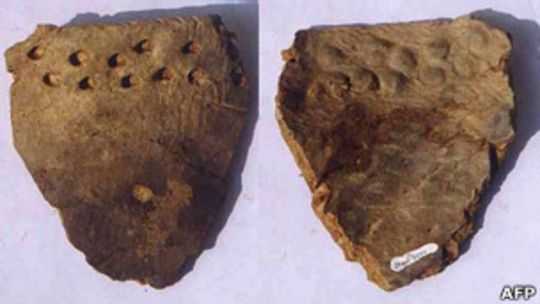

Sean bienvenidos, a una nueva aclaración, arqueológica-histórica, en esta ocasión aclararemos y desmentir errores aplicados a la arqueología .¿Por qué la cerámica más antigua se encuentra en Asia y no en el mediterráneo?.
-
En cierto modo, muchas de las cosas más antiguas se encuentran en mesopotamia, pero no todo ya que muchas cosas surgieron en china y japón. En este caso, hablaremos de la cerámica, los vestigios más antiguos los podemos encontrar en el archipiélago nipón de hace 16.500 años de antigüedad durante el periodo Jōmon(Neolítico japonés lo que equivaldría al neolítico Europeo), eso era lo que se sabía hasta ahora, pero restos arqueológicos rescatados en una cueva de china, datan de una friolera de 20.000años, se tenía entendido que la cerámica apareció hace 10.000 años aproximadamente, ¿Por que se nos ocultan estos datos?, pues muy sencillo, porque no concuerdan con la recta cronológica estipulada, además de no generar interés para su estudio.
-
La foto número 1, son los restos de la cerámica china.
-
La foto número 2 es la cerámica de la cultura Jōmon.
-
Cualquier aportación siempre es bienvenida, ya que esta publicación sirve como aclarar ideas y para debatir. os deseo un buen día y un fuerte abrazo.
-
新しい考古学と歴史の解明へようこそ。今回は、考古学に適用された誤りを明らかにし、否定します。なぜ最も古いセラミックが地中海ではなくアジアで見つかったのでしょうか。
-
ある意味で、最も古いものの多くはメソポタミアで発見されていますが、中国と日本で発生したものほど多くはありません。今回は陶磁器についてお話しますが、16、500年前の縄文時代(ヨーロッパの新石器時代に相当する日本の新石器時代)の日本列島で最も古い遺跡がありますが、これは今まで知られていましたが、中国の洞窟で救出された考古学的遺跡は、なんと2万年前のもので、約1万年前に陶磁器が登場したと理解されていましたが、なぜこれらのデータが私たちから隠されているのでしょうか。直線と一致しないため、非常に単純です。その研究への関心を生み出さないことに加えて、年代順に規定された。
-
写真1は中国の陶器の残骸です。
写真2は縄文文化の陶器です。
この投稿は説明と議論として役立つので、どんな入力でもいつでも歓迎します。良い一日と大きな抱擁をお祈りします。
-
Welcome to a new archaeological-historical clarification, this time we will clarify and deny errors applied to archeology. Why is the oldest ceramic found in Asia and not in the Mediterranean ?.
-
In a way, many of the oldest things are found in Mesopotamia, but not all as many things arose in China and Japan. In this case, we will talk about ceramics, the oldest remains can be found in the Japanese archipelago 16,500 years ago during the Jomon period (Japanese Neolithic, which would be equivalent to the European Neolithic), that was what was known until now, but archaeological remains rescued in a cave in China, dating from a whopping 20,000 years, it was understood that the ceramics appeared approximately 10,000 years ago, why are these data hidden from us ?, Well very simple, because they do not agree with the straight line stipulated chronological, in addition to not generating interest for its study.
-
Photo number 1 is the remains of Chinese pottery.
Photo number 2 is the pottery of the Jomon culture.
Any input is always welcome, as this post serves as clarification and discussion. I wish you a good day and a big hug.
#歴史#考古学#中国#日本#セラミカ#レストサルケオロギコス#クエヴァチナ#仙人洞#クエバ仙人洞#歴史セラミカ#セラミカ考古学#アジア#ヒストリアアジア#歴史日本#考古学アニポナ#考古学日本ポネサ#考古学日本#縄文#文化縄文#ネオリティコ日本#ネオリティコヨーロッパ#-#history#archaeology#china#japan#ceramics#archaeological remains#chinese cave#Xianrendong
42 notes
·
View notes
Text




Quite mesmerized by this Middle Jōmon period pottery (ca. IV-III millennium BCE).
Jōmon pottery is the oldest example of pottery attested in Japan and among the oldest in the world, dating back to 12000-11000 BCE (some sources even say 14000 BCE)
#history#history of art#pottery#japanese#I'm studying for my archeology exam and procrastinating so hard#these were pretty useless in practical means#they were probably used for rituals#making something absolutely useless just because it's pretty it's peak humanity#i love us
19 notes
·
View notes
Text

Kanzashi (簪) are hair ornaments used in traditional Japanese hairstyles. In Old times, men gave Kanzashi to a very special women not only for the marriage proposal. Kanzashi is thought to be like an 'Omamori' (an amulet) as it can be used as a tool for self-defense and during the Jōmon period, it was said to ward evil spirits. Seemingly, these male suitors wanted to give it not only as a fashion statement and symbol of wealth for their beloved, but also as a tool that could save her while they were not with their women.
SessKik (X)
82 notes
·
View notes
Text
TMMN Alien Society - Analysis
This is only based on little lore we know and is just my analysis and theory

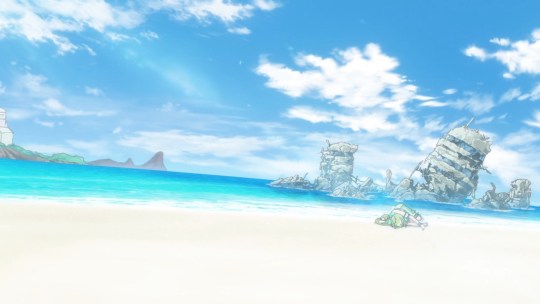
Based on the landscapes, the suken buildings, the vulcano in the background, the tropical plants etc, we can assume this was pre-modern humans Japan, Hunter-gatherers arrived in Japan in Paleolithic times, 30,000 BC but the Japanese archpelago dates back as far as 100,000 years.

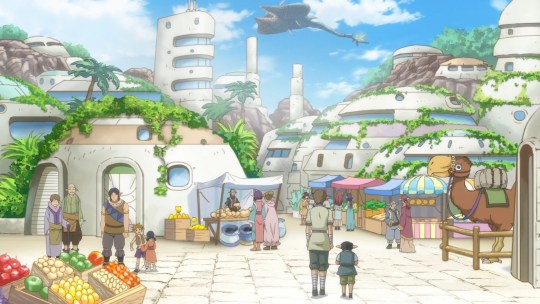
Jōmon Culture ( REAL LIFE / EARTH EVENTS)
Middle Jōmon (ca. 2500–1500 B.C.)
This period marked the high point of the Jomon culture in terms of increased population and production of handicrafts.
Look who has lots of ceramic’s

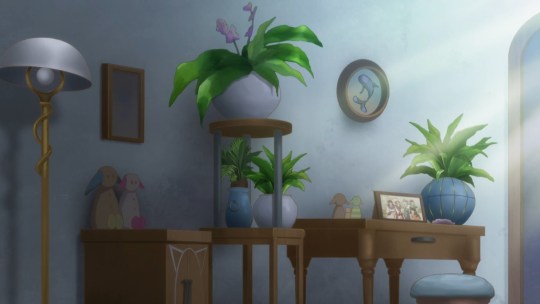
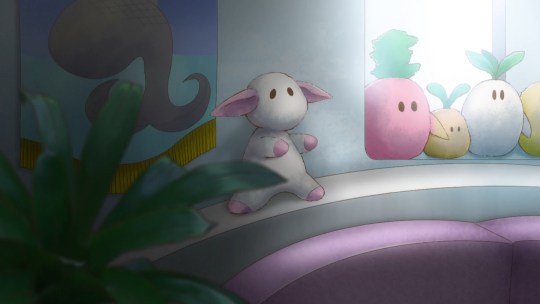
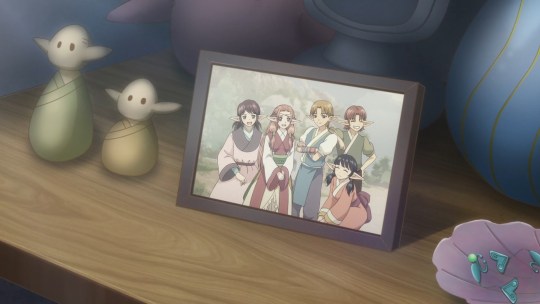
handcrafts

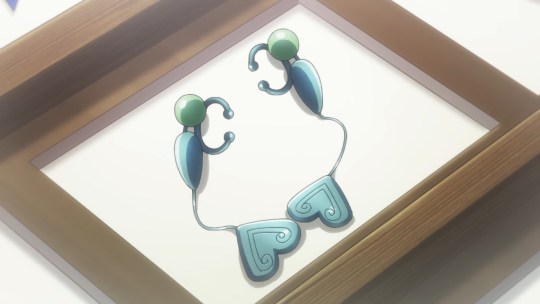
The warming climate peaked in temperature during this era, causing a movement of communities into the mountain regions.

Late Jōmon (ca. 1500–1000 B.C.)
As the climate began to cool, the population migrated out of the mountains and settled closer to the coast, especially along Honshū’s eastern shores. Greater reliance on seafood inspired innovations in fishing technology, such as the development of the toggle harpoon and deep-sea fishing techniques. This process brought communities into closer contact, as indicated by greater similarity among artifacts. Circular ceremonial sites comprised of assembled stones, in some cases numbering in the thousands, and larger numbers of figurines show a continued increase in the importance and enactment of rituals.
Final Jōmon (ca. 1000–300 B.C.)
As the climate cooled and food became less abundant, the population declined dramatically. Because people were assembled in smaller groups, regional differences became more pronounced. As part of the transition to the Yayoi culture, it is believed that domesticated rice, grown in dry beds or swamps, was introduced into Japan at this time.
This all seems to tie perfectly with the alien race in Tokyo Mew Mew New.
Fauna: This goofy bird reminds me of a bird of terror
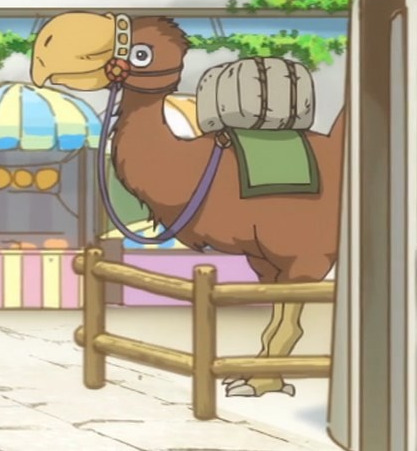
Phorusrhacids, colloquially known as terror birds, are an extinct family of large carnivorous flightless birds that were among the largest apex predators in South America during the Cenozoic era; their conventionally accepted temporal range covers from 53 to 0.1 million years ago. They ranged in height from 1 to 3 m.
Aliens domesticating terror birds? BASED.
But aren’t them specific to America? Yeah but this is an anime with aliens and magical girls and genetic modified humans XD so maybe terror birds could have existed in Japan in this timeline...or some regular herbivore bird simply evolved into a big BIRB.
Well back to the main topic, the enviroment and climate change, like real life records show, this “region” climate began to warm so much it started raising the sea level.


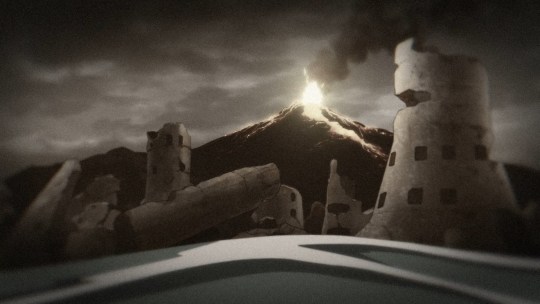
But why some refuse to leave?

if we think of real life experience: wars and dramatic climate changes can lead people to find a new way to survive elsewhere or on the other side to stay and try to overcome the difficulties, ti is always been like that.
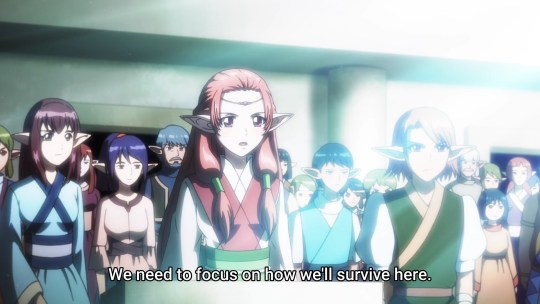
they're afraid of the unknown, what waits them out there may be worst than their fate on earth sentimental behavior,elders etc


My theory is that, they’ve sent a couple of aliens into the new world in order to build a decent new home for everyone, once their new home was established they would come back and take the rest with them.
But sadly the disaster occured too soon, before the previous team could have contact with the “aliens on earth”-
Probably the human species could have develop from the previous “aliens” that survived and lost their “alien” characterisitcs or simply evolved the normal way real humans did
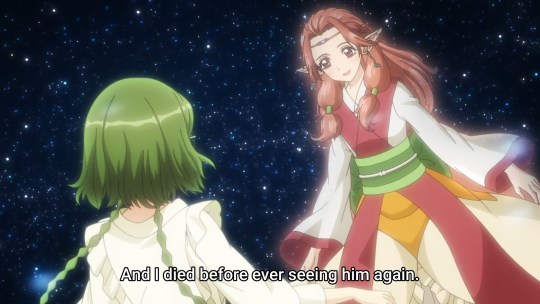
Source for Jomon culture
65 notes
·
View notes
Note
You know my biggest disapointment with breath of the wild was the Shiekah, they turned the VERY indian inspired group into bland ass ninjas and in the story that most revolves around the shiekah's agency that feels off, i suppose an indian group being servants of a european monarchy sucks but the erasure still leaves a bad taste in my mouth, what do you think?
I've never heard that the Sheikah were inspired by Indian art. Which does not mean it can't be a read-- I just haven't encountered it before. I WILL say that I noticed a LOT of architecture inspired by South Asia and India in Skyward Sword. But the dungeons and ruins in that game are rarely associated with a specific people, only 'the ancient past' and 'the goddess Hylia'. I wish we actually got confirmation that ancient Sheikah were associated with those ruins, rather than the only direct clue to Sheikah culture in that game being a time traveling exposition lady.
We had really few direct depictions of Sheikah architecture and customs before BotW, and in that game the 'ancient' Sheikah features were designed with the Jōmon period, the earliest known Japanese art and culture. The 'modern' Sheikah features were also very Japanese in aesthetic.
This kind of brings me to the point I want to bring up and reply to in your ask, which is that I take slight issue with the idea that Hyrule is a 'European monarchy.' I think it could be easy to read it that way where I live, because we tend to trust the aesthetics of stuff in a story to match up to locations in 'real life.' If we see a guy wielding a 14th century straight longsword we tend to assume the guy, within the bounds of style, is a medieval European dude. We don't expect him to lift his helm visor and reveal he's Japanese.
But for the same reason we look at anime characters and assume that many of them are probably intended to scan as Japanese to a Japanese audience, I think we need to extend that to Legend of Zelda. Even though the Hylian monarchy isn't wearing fashions that look Japanese, their nationalist myth throughout many games is set up to be extremely familiar to the domestic Japanese audience. Link and Zelda may be Blondes but the Sheikah analogs to a 'japan' themed culture are given white hair.
(Somebody else than me might have better insight into Anime Hair Colors.)
I live in the USA, 'the west', so by default narratives about imperialism and orientalism most accessible to me are going to assume whiteness and euro-centrism. But I feel it would be wrong to frame a piece of Japanese media as about whiteness, especially when it's clear that we can see the same type of stuff happen wherever racism and imperialism intersect.
There's only so much detail or nuance I can really have, given that I'm a white person in the anglosphere who's able to take Asian Literature in college, and Use Wikipedia, and Compare mythology, history, and news out of other countries to Video Games.
But yes, with all that said. It does put bad tastes in my mouth. Basically any depiction of entire cultures existing in some way to ensure a monarchy's security will do that, and the recent installment TotK extends to other fantasy races the horrible fate that has always been slapped onto the Sheikah: bound by an oath to serve Hyrule, Zelda and by extension, Link who paradoxically exists to both be the nation's tool but also the inheritor of everything in it.
#botw#totk#totk spoilers#totk critical#legend of zelda#the hylians are japanese and their imperial myth is japanese and their artifacts are japanese and the game is comfort food to japanese norm#and that doesn't make any of the issues better
32 notes
·
View notes